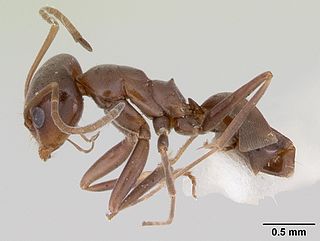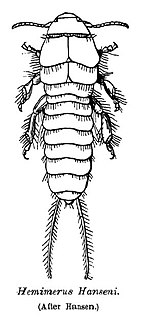 W
WAnillidris is a genus of ants which only contains the species Anillidris bruchi. The genus is known only from a few collections in Brazil and Argentina. For a time Anillidris was synonymous with genus Linepithema, but was revived from synonymy by Shattuck (1992).
 W
WAphylla williamsoni, known generally as the "two-striped forceptail", is a species of clubtails in the family Gomphidae. It is found in North America.
 W
WCrenigomphus renei is a species of dragonfly in the family Gomphidae. It is found in the Republic of the Congo, the Democratic Republic of the Congo, Ivory Coast, Ghana, Kenya, Nigeria, Tanzania, Uganda, and possibly Malawi. Its natural habitats are subtropical or tropical dry shrubland, subtropical or tropical moist shrubland, rivers, freshwater lakes, and freshwater marshes.
 W
WDiogmites crudelis is a species of robber flies in the family Asilidae.
 W
WDiogmites esuriens is a species of robber flies in the family Asilidae.
 W
WDiogmites properans is a species of robber flies in the family Asilidae.
 W
WDorymyrmex smithi is a species of ant in the genus Dorymyrmex. Described by Cole in 1936, the species is endemic to the United States and Mexico.
 W
WDrosophila subobscura is a species of fruit fly in the family Drosophilidae. Originally found around the Mediterranean, it has spread to most of Europe and the Near East. It has been introduced into the west coasts of Canada, the United States, and Chile. Its closest relative is Drosophila madeirensis, found in the Madeira Islands, followed by D. guanche, found in the Canary Islands. These three species form the D. subobscura species subgroup. When they mate, males and females perform an elaborate courtship dance, in which the female can either turn away to end the mating ritual, or stick out her proboscis in response to the male's, allowing copulation to proceed. D. subobscura has been regarded as a model organism for its use in evolutionary-biological studies.
 W
WHemimerus is a genus of earwigs, in the family Hemimeridae. It is one of two genera in the family of Hemimeridae, and contains ten species:Hemimerus advectus Rehn & Rehn, 1936 Hemimerus bouvieri Chopard, 1934 Hemimerus chevalieri Chopard, 1934 Hemimerus deceptus Rehn & Rehn, 1936 Hemimerus hanseni Sharp, 1895 Hemimerus prolixus Maa, 1974 Hemimerus sessor Rehn & Rehn, 1936 Hemimerus talpoides Walker, 1871 Hemimerus vicinus Rehn & Rehn, 1936 Hemimerus vosseleri Rehn & Rehn, 1936
 W
WHemimerus is a genus of earwigs, in the family Hemimeridae. It is one of two genera in the family of Hemimeridae, and contains ten species:Hemimerus advectus Rehn & Rehn, 1936 Hemimerus bouvieri Chopard, 1934 Hemimerus chevalieri Chopard, 1934 Hemimerus deceptus Rehn & Rehn, 1936 Hemimerus hanseni Sharp, 1895 Hemimerus prolixus Maa, 1974 Hemimerus sessor Rehn & Rehn, 1936 Hemimerus talpoides Walker, 1871 Hemimerus vicinus Rehn & Rehn, 1936 Hemimerus vosseleri Rehn & Rehn, 1936
 W
WHemimerus is a genus of earwigs, in the family Hemimeridae. It is one of two genera in the family of Hemimeridae, and contains ten species:Hemimerus advectus Rehn & Rehn, 1936 Hemimerus bouvieri Chopard, 1934 Hemimerus chevalieri Chopard, 1934 Hemimerus deceptus Rehn & Rehn, 1936 Hemimerus hanseni Sharp, 1895 Hemimerus prolixus Maa, 1974 Hemimerus sessor Rehn & Rehn, 1936 Hemimerus talpoides Walker, 1871 Hemimerus vicinus Rehn & Rehn, 1936 Hemimerus vosseleri Rehn & Rehn, 1936
 W
WHemimerus is a genus of earwigs, in the family Hemimeridae. It is one of two genera in the family of Hemimeridae, and contains ten species:Hemimerus advectus Rehn & Rehn, 1936 Hemimerus bouvieri Chopard, 1934 Hemimerus chevalieri Chopard, 1934 Hemimerus deceptus Rehn & Rehn, 1936 Hemimerus hanseni Sharp, 1895 Hemimerus prolixus Maa, 1974 Hemimerus sessor Rehn & Rehn, 1936 Hemimerus talpoides Walker, 1871 Hemimerus vicinus Rehn & Rehn, 1936 Hemimerus vosseleri Rehn & Rehn, 1936
 W
WHemimerus is a genus of earwigs, in the family Hemimeridae. It is one of two genera in the family of Hemimeridae, and contains ten species:Hemimerus advectus Rehn & Rehn, 1936 Hemimerus bouvieri Chopard, 1934 Hemimerus chevalieri Chopard, 1934 Hemimerus deceptus Rehn & Rehn, 1936 Hemimerus hanseni Sharp, 1895 Hemimerus prolixus Maa, 1974 Hemimerus sessor Rehn & Rehn, 1936 Hemimerus talpoides Walker, 1871 Hemimerus vicinus Rehn & Rehn, 1936 Hemimerus vosseleri Rehn & Rehn, 1936
 W
WMegachile pseudobrevis, the southeastern little leaf-cutter bee, is a species of hymenopteran in the family Megachilidae.
 W
WThe family Mormotomyiidae contains only one known species, Mormotomyia hirsuta, commonly known as the frightful hairy fly or terrible hairy fly, which is found in Kenya. The fly was first described by English entomologist Ernest Edward Austen, and specimens have been collected from one location on a mountain in the Ukasi Hill, in a cleft where a bat roost is located; this may possibly be the most restricted geographic distribution for any fly family. The larvae have been collected from bat guano. Adult flies are believed to feed on bodily secretions of bats. The fly measures about 1 cm long, with hairy legs, and, due to its nonfunctional wings and tiny eyes, looks more like a spider than a fly. Specimens have been collected only three times, in 1933, 1948, and 2010. Tested members of the population showed higher levels of genetic variation than would be expected for such a restricted range, suggesting additional undiscovered populations exist and gene flow occurs between them and the known population in Ukasi Hill.
 W
WRhodopsalta microdora, also known as the little redtail cicada, is a species of insect that is endemic to New Zealand. This species was first described in 1936 by George Vernon Hudson and named Melampsalta microdora.